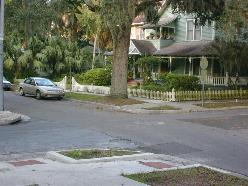By Dom Nozzi
Conventional traffic engineers (the people who have been designing our roads for the past century) often like to make the claim that their design strategy is to make the road more “safe.” The tragic irony is that a great many of their “safety” tactics actually make the road much less safe.
And that helps explain why today, we have an epidemic of unsafe, inattentive motorists driving at excessively dangerous speeds. What could be more ironic?
Here is an excellent, common example of how our roads become less safe in the name of “improved safety”:
A road intersection have what are called a “turning (or “curb”) radius.” This radius is a measurement of the tightness or width of the corner of the intersection. The following image illustrates a tight radius vs a wide radius…
Too often, the conventional traffic engineer will recommend a wider turn radius for “safety.” He or she will frequently state that a wider radius is needed to help improve pedestrian safety. Without a wider radius – the engineer will often claim—motorists will sometimes jump the curb, which would endanger pedestrians.
Nonsense.
What actually happens in the real world is that the wider radius allows most motorists to negotiate the turn at a much higher (and more inattentive) speed, and there is very little that is more dangerous than a motorist driving at excessive speeds inattentively. If a motorist “jumping the curb” was truly a problem, hardened bollards should be placed at the curb to to punish or otherwise discourage reckless, excessively speeding driving.
Another canard that the engineer often pulls out is that the wider radius is needed because the road is used by very large vehicles (such as buses or trucks). The large vehicle becomes what is called the “design vehicle” that the engineer uses to design the road geometries.
But again, the unintended consequence emerges. By enabling the large vehicle to negotiate a turn with a wider turn radius, we induce the high-speed, inattentive driving by the much more common passenger vehicle. Overall safety goes down as a result, because while a large truck jumping a curb is perhaps averted by the wide radius, such vehicles are quite rare, whereas the smaller passenger vehicles which are induced to drive more recklessly are much more common.
In a walkable downtown, it is ass backwards to use a large vehicle as the design vehicle for designing the streets. The pedestrian should be the design “vehicle” if a town center is to be designed for walkability. Using a large vehicle as the design vehicle utterly undercuts the objective of creating a safe, walkable street design for pedestrians.
There are much more appropriate strategies for dealing with large vehicles in a town center that is intended to be walkable. First, the effective turn radius can be made wider without creating the unintended consequences I mention above. This can be done quite simply by adding on-street parking close to the intersection. Or, the community can prohibit the use of large vehicles in the town center.
When conventional traffic engineers mention “safety,” watch out. Usually, it is just a smoke screen to grab the moral high ground at a public meeting concerning street design. Meanwhile, the man behind the curtain that we are not supposed to notice is designing the street for a single-minded objective: Higher motor vehicle speeds — which, of course, degrades our safety and quality of life.
Tactics such as wider intersection turn radii usually fall under the category of the conventional “forgiving street” philosophy, whereby we “forgive” reckless, high-speed, out of control driving by eliminating things that motorists might run into, such as trees, pedestrians, buildings, parked cars, etc.





